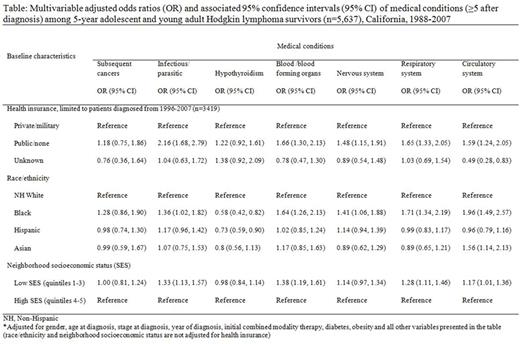Abstract
Introduction: Survivors of Hodgkin lymphoma (HL) experience high risks of second cancers and cardiovascular disease. However, few population-based studies have focused on these risks in adolescents and young adults (AYAs) and none have considered whether the occurrence of these and other medical conditions differ by sociodemographic factors in long-term AYA HL survivors.
Methods: Data for 5,667 patients aged 15-39 when diagnosed with HL during 1988-2007 and surviving a minimum of 5 years from diagnosis were obtained from the California Cancer Registry and followed in California hospital, emergency department and ambulatory surgery discharge databases. Discharge diagnoses were categorized to classify medical conditions as hypothyroidism, or infectious, blood, nervous, respiratory, and circulatory system conditions. Second cancers were obtained from the cancer registry. We estimated the cumulative incidence of developing each medical condition ≥ 5 years after diagnosis, accounting for death as a competing risk, stratified by race/ethnicity, neighborhood socioeconomic status (SES) at diagnosis, and health insurance status at diagnosis/initial treatment (available from 1996-2012). We examined the impact of these baseline sociodemographic characteristics on the occurrence of medical conditions using multivariable logistic regression and the impact of medical conditions on mortality using multivariable Cox proportional hazards regression with medical conditions as time-dependent covariates. Results are presented as adjusted odds ratios (OR) or hazard ratios (HR) with 95% confidence intervals (CI).
Results: Forty-eight percent (n=2,710) of AYAs experienced one medical condition and 31% (n=1,718) had two or more medical conditions ≥ 5 years from HL diagnosis. AYAs survivors with public or no insurance (vs private) had a greater likelihood of experiencing all medical conditions, except second cancers and hypothyroidism (Table). More than 27% of AYAs with public or no insurance (vs private) experienced infectious (28% vs 14%), blood (28% vs 19%), respiratory (39% vs 26%) and circulatory system (34% vs 24%) conditions at 15-years after diagnosis. Compared to non-Hispanic Whites, blacks had a higher likelihood of all medical conditions except second cancers and hypothyroidism; Asian/Pacific Islanders had a higher likelihood of circulatory system diseases (Table). The incidence of infectious (23%), blood (30%), respiratory (36%) and circulatory system (35%) conditions were significantly higher among Black AYA HL survivors at 15-years than AYAs of other race/ethnicities (all p values <0.001). Consistent with the multivariable logistic regression analyses (Table), AYAs residing in low (vs high) SES neighborhoods had a higher incidence of infectious (18% vs 12%), blood (21% vs 15%), respiratory (27% vs 20%) and circulatory system (23% vs 18%) conditions at 15-years after diagnosis (all p values <0.001). The risk of death was increased among AYAs with blood conditions (HR=4.73, CI: 3.59-6.23), respiratory conditions (HR=3.73, CI: 2.87-4.85), infectious conditions (HR=3.11, CI: 2.43-3.99), subsequent cancers (HR=3.03, CI: 2.40-3.82) and circulatory system conditions (HR=2.85, CI: 2.24-3.61).
Conclusion: This study found that 5-year AYA HL survivors who were uninsured or publicly insured, of Black or Asian/Pacific Islander race/ethnicity, or who resided in lower SES neighborhoods were at higher risk for developing late medical conditions and mortality. Lack of access to preventive care and long-term surveillance associated with low SES and lack of health insurance may explain these findings. Survivorship programs should target these more vulnerable populations and these conditions to improve patient outcomes.
Flowers:AbbVie: Research Funding; Genentech: Consultancy, Research Funding; Infinity: Research Funding; NIH: Research Funding; ECOG: Research Funding; Mayo Clinic: Research Funding; Roche: Consultancy, Research Funding; Millenium/Takeda: Research Funding; Gilead: Consultancy, Research Funding; TG Therapeutics: Research Funding; Acerta: Research Funding; Pharmacyclics, LLC, an AbbVie Company: Research Funding.
Author notes
Asterisk with author names denotes non-ASH members.


This feature is available to Subscribers Only
Sign In or Create an Account Close Modal